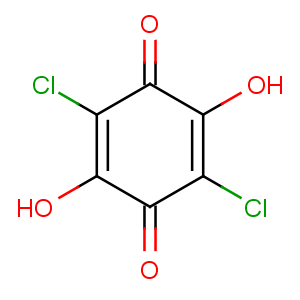Title: Chloranilic Acid
CAS Registry Number: 87-88-7
CAS Name: 2,5-Dichloro-3,6-dihydroxy-2,5-cyclohexadiene-1,4-dione
Synonyms: 2,5-dichloro-3,6-dihydroxy-
p-benzoquinone
Molecular Formula: C6H2Cl2O4
Molecular Weight: 208.98
Percent Composition: C 34.48%, H 0.96%, Cl 33.93%, O 30.62%
Literature References: Prepd from chloranil by alkaline hydrolysis: Conant, Fieser,
J. Am. Chem. Soc. 46, 1866 (1924).
Properties: Red crystals, mp 283-284°. Tendency to sublime. Relatively strong dibasic acid. Absorption max (pH 4 in water): 290-340 nm, 520-555 nm.
Melting point: mp 283-284°
Absorption maximum: Absorption max (pH 4 in water): 290-340 nm, 520-555 nm
Use: Reacts with metal cations to form stable salts. Used in spectrophotometry: Hart,
Org. Chem. Bull. 33, no. 3 (1961).

